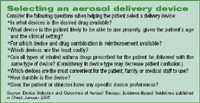New guidelines declare all inhalers are comparable
The number of different devices for delivering inhaled medications has multiplied in the past two to three decades. Dozens of new products have hit the market since the 1970s. While the bounty of choices gives prescribers the flexibility to meet their patients' needs, information guiding prescribers through device selection was not readily available until recently.
The number of different devices for delivering inhaled medications has multiplied in the past two to three decades. Dozens of new products have hit the market since the 1970s. While the bounty of choices gives prescribers the flexibility to meet their patients' needs, information guiding prescribers through device selection was not readily available until recently.
The American College of Chest Physicians (ACCP) and the American College of Allergy, Asthma & Immunology (ACAAI) have teamed up to develop evidence-based guidelines for selecting aerosol delivery devices (nebulizers and inhalers). "There was much confusion about which devices to use," said Myrna B. Dolovich, P.Eng, associate clinical professor of medicine and radiology at Ontario's McMaster University. It was Dolovich who chaired the international panel that produced the guidelines.

Dolovich did not find the results surprising. She cautioned, however, that it was still difficult to get a completely accurate review of all devices because trials involving bronchodilators outnumbered those for corticosteroids-most likely due to the more complicated nature of corticosteroid trials. Longer treatment periods are required, and washout periods are necessary between crossover arms. More corticosteroid studies are needed, Dolovich said. Although brochodilators are easier to study because they are short-acting, there are limitations to reviewing these studies as well.
While the authors of other studies have concluded that prescribers should choose products based solely on their price, the ACCP-ACAAI joint panel recommended that device selection should be determined by evaluating each individual patient and situation and not price alone.
According to the ACCP-ACAAI report, up to 70% of patients do not use their inhalers correctly. Studies also have determined that many practitioners do not know how to properly operate aerosol devices. Physicians, respiratory therapists, nurses, and other healthcare workers who prescribe and administer inhaled medications need to be familiar with all the devices.
Physicians, nurses, and respiratory therapists know the proper use of aerosol devices in order to teach their patients, said Dolovich. If patients do not use their devices correctly, they will not receive the appropriate dose of medication. "Each time patients visit the office, they need to have their technique checked," she said.
Package inserts provide detailed, device-specific instructions. On-line help is available from http://www.safemedication.com/, the Food & Drug Administration, asthma associations, The Lung Association (Ontario), ACCP, Mothers of Asthmatics, and pharmacy organizations. Most of these organizations also offer advice in print form.
Because pharmacists are more readily accessible, they are perfectly positioned to educate patients on use, storage, and cleaning of inhalers and other devices. Dolovich said pharmacists should be prepared to answer questions from patients as well as prescribers and therapists. Pharmacists are their key resources.
"There are new products coming along that are more sophisticated," said Dolovich. They will deliver a more accurate dose, with a goodquality aerosol that will enter the lungs efficiently. By keeping their knowledge of aerosol devices current, pharmacists can play a vital role in asthma treatment.
Targeted Drug Combination Reveals New Activity in Brain Tumors
December 28th 2021A combination of two targeted cancer drugs showed unprecedented, “clinically meaningful” activity in patients with highly malignant brain tumors that carried a rare genetic mutation, according to a clinical trial report by investigators from Dana-Farber Cancer Institute.